LEAFING THROUGH AGROFORESTRY PRACTICES
FOREST, FARMER, FLAVOUR, FUTURE & FUN

As you may know, at Silva, we take pride in our unique focus on the forest, the farmers, flavours, and the future, all while having fun.
F IS FOR FOREST
It all starts with our name ‘Silva’. Chosen for a good reason. ‘Silva’ means ‘forest’ in Latin, highlighting the origin of cacao trees (Theobroma cacao L.), native to the rainforests of the Amazon and Orinoco river basin. Silva: noun, sil va | \ˈsil-və , the forest trees of a region or country.
Cacao -native to the tropical forests of the upper Amazon basin, has been cultivated for thousands of years. Ancient civilisations like the Mayans and Aztecs treasured cacao not just for its nutritional and economic value but also for its spiritual significance. Cacao thrives under forest canopies, coexisting harmoniously with diverse plant life and evolving alongside surrounding biodiversity. Theobroma cacao does best when sheltered from harsh sunlight beneath taller vegetation.
This intimate bond between cacao and forests underscores a core concept: rather than clear-cutting vast stretches of land for single-crop plantations, farmers embrace a more holistic approach. Through agroforestry, they integrate cacao cultivation within a diverse mix of other beneficial tree species. This strategy, known as ‘agroforestry’, presents an ecologically robust alternative, fostering sustainable cacao production while safeguarding our precious forest ecosystems.
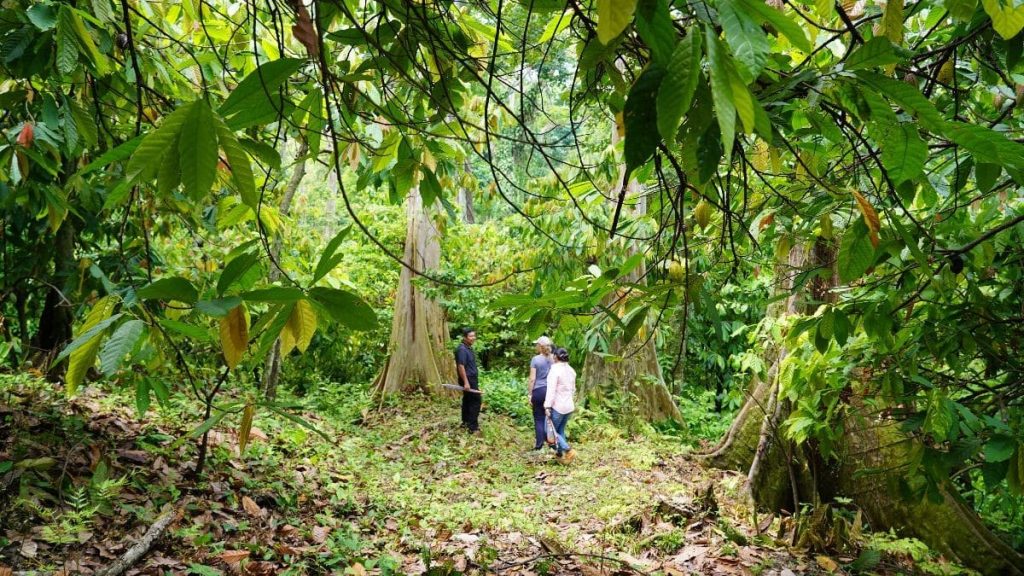
Given our affinity and practical and solid knowledge of the terrain -as you know, we regularly put on our hiking boots and go into the jungle, we thought it was time to share our insights on the hot topic of ‘agroforestry’.
We’ll dive deep into the forest -both literally and figuratively, to guide you through different types and applications. We assess the benefits and challenges, and take a look at the future of cacao -an interesting balancing act.
With this (agroforestry) framework we want to provide you first and foremost with knowledge and background insights, so that you can better interpret and understand the ecological value of your cacao purchases.
WHAT IS AGROFORESTRY?
As a European importer of specialty cacao deeply committed to environmental stewardship and actively involved in the EU Green Deal, we rely on the expertise of organisations such as FAO (Food and Agriculture Organisation of the United Nations) and CIFOR/ICRAF (The Center for International Forestry Research and World Agroforestry). It’s only logical and relevant that we refer to their framework when considering agroforestry.
According to the Food and Agriculture Organisation (FAO), agroforestry is a land-use system that intentionally integrates woody perennials like trees, shrubs, and palms with agricultural crops or animals on the same land. It’s considered a dynamic and ecologically based approach to natural resource management, aiming to diversify and sustain production for enhanced economic, social, and environmental benefits. This adaptable practice is widely adopted globally, tailored to local environmental, cultural, and socio-economic conditions, offering particular value to smallholder farmers.
The Center for International Forestry Research (CIFOR) and the World Agroforestry Centre (ICRAF) define agroforestry as a land management strategy that combines trees and shrubs with agricultural crops or livestock on the same land, using various spatial and temporal arrangements. This approach aims to maximise benefits from both agriculture and forestry, improving productivity, resilience, and sustainability while offering economic, social, and environmental advantages to land users. Agroforestry practices differ greatly across landscapes and regions, reflecting local environmental conditions, cultural preferences, and socioeconomic factors.

So nailing the shade balance in cacao agroforestry is paramount. We can say that agroforestry -as mystifying as the term may seem at first, is actually quite simple. It’s a holistic approach to managing and integrating trees, crops, and livestock on the same plot of land. The primary idea behind agroforestry is creating a synergistic environment where each component benefits from the others. The principles focus on promoting biodiversity, reducing soil erosion, and sequestering carbon. Moreover, it thrives on enhancing productivity through nutrient cycling and providing habitats for wildlife.
SHADY’ BUSINESS
50 SHADES OF SHADE
In its natural habitat, cacao grows in the shade of larger trees. In fact, 70% of the world’s cacao is grown with ‘some’ level of shade. This comes mostly from native forest trees, thinned out to provide space for cacao seedlings to be planted, or to a lesser extent, from trees specially planted to provide shade. This mixture of shade trees and shrubs creates a three-tier canopy, resulting in a multi-species system similar in structure and function to a forest, known as an agroforestry.
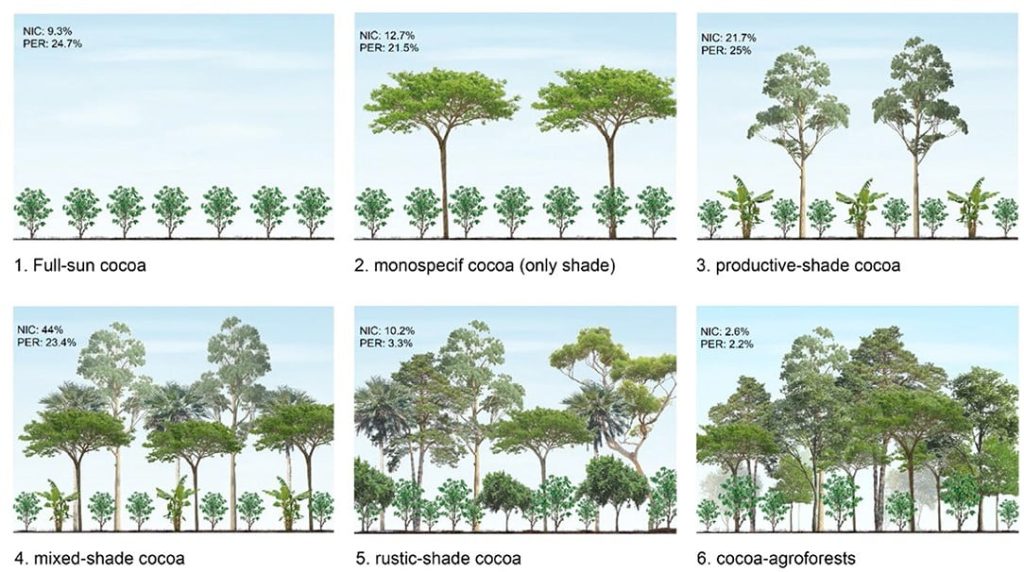
->>> Shade grown cacao is basically an integration of agriculture and forest, and therefore a type of agroforestry.
->>> A canopy of diverse species of shade trees is created to grow cacao in agroforestry.
GETTING THE SHADE RIGHT
Achieving an appropriate level of shading is important when we are dealing with cacao. It directly impacts yield and can sway the occurrence of pests and diseases. Furthermore, shading in cacao contributes significantly to biodiversity preservation.
An effective method for assessing the ‘diversity of shade’ is by assessing both the percentage of shade coverage, the different types and levels of shade present and the species within these layers. The number of shade layers (in height) and the diversity of shade types within these layers (in width) are key factors in determining the ecological value of shade-grown coffee systems.
->>> Nailing the shade balance in cacao agroforestry is paramount.
BEYOND SHADE
% OF SHADE, DIVERSITY OF SHADE, THE BIODIVERSITY WITHIN SHADE, …
Traditional shade-friendly cacao’s have been widely acknowledged for their significant benefits. Shade-grown cacao stands as a prime example of sustainable agroforestry, with cacao plants flourishing under a diverse canopy of trees. This shading not only shields the cacao crop from harsh weather elements but also fosters a habitat where biodiversity flourishes, ultimately contributing to a healthier ecosystem.
To fully grasp the ecological significance of shade-grown cacao, it’s crucial to look beyond just technical details like the percentage of shade. While these details are important, they only offer a partial understanding.
We must delve deeper into the biodiversity within the shade cacao system and consider all the implications that contribute to a more harmonious balance between nature and agricultural production. This broader perspective encompasses benefits that extend to economies, communities, and the planet as a whole.
->>> To truly understand the complete ecological value of shade-grown cacao, we must move beyond merely considering percentages of shade and biodiversity.
AGROFORESTRY IN THE CACAO VALUE CHAIN
THE BALANCING ACT:
BALANCING THE BENEFITS WITH THE PRACTIAL CHALLENGES
Agroforestry presents a wealth of advantages for forests, farmers, flavour, and the future:
- Improved Soil Health & Fertility: Integrating shade trees replenishes nutrients, reduces erosion, and retains moisture for robust cacao growth.
- Increased Biodiversity & Ecosystem Services: Supporting diverse flora and fauna enhances crop yield, pest control, and attracts eco-tourism.
- Climate Change Mitigation & Adaptation: Acting as a carbon sink, agroforestry absorbs CO2, while shade trees protect cacao plants from extreme weather, aiding in climate resilience.
- Pest & Disease Control: Ecological diversity supports natural pest predators, reducing reliance on chemical inputs.
- Enhanced Water Availability: Forest soils retain more water, benefiting cacao growth, and reducing evapotranspiration.
- Enhanced Quality & Flavour Diversity: Shade slows cacao pod maturation, allowing for the development of desirable flavour compounds, resulting in sweeter and more complex cacao.
Sustainable Resource Management: Diversified income sources promote economic stability while preserving the environment for future generations.
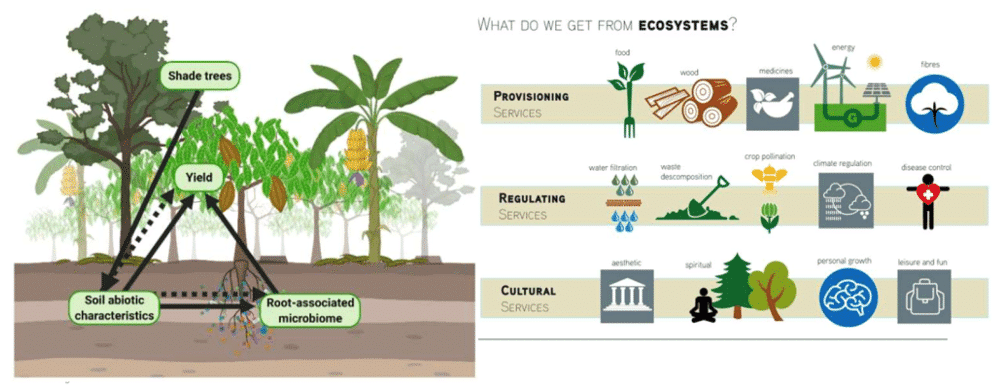
Overall, while shade is beneficial for cacao cultivation, an overly dense canopy can hinder productivity and increase the risk of plant health issues.
- When the canopy is too dense, it restricts sunlight from reaching the cacao plants, which are essential for photosynthesis and optimal growth. As a result, cacao yields may decrease.
- Furthermore, in a dense canopy, cacao plants may compete with surrounding trees for nutrients and water, leading to nutrient deficiencies and water stress. This competition can weaken the cacao plants and make them more susceptible to diseases and pests. Additionally, overcrowding can inhibit air circulation, creating a more humid environment that is conducive to fungal infections and other diseases.
->>> Therefore, it’s essential to maintain an appropriate balance of shade to ensure optimal growing conditions for cacao plants.
!!! Don’t be blinded by the label/term ‘organic’. Organic means the absence of chemicals in the supply chain, but does not necessarily imply great value for nature.
Some cacao’s may be certified organic but contribute minimal value for nature. On the other hand, there are also cacao’s that offer great value for nature, but do not carry the ‘organic’ label.
It is important not to confuse the two. Also keep in mind that many production systems are organic ‘by default’, simply because some farmers do not have access or resources to inputs.
Agroforestry presents a nuanced approach to the future of cacao cultivation. While it holds promise for addressing industry challenges like soil health and biodiversity, transitioning to agroforestry requires significant investments and changes in farming practices, especially for small-scale farmers. Balancing these benefits with practical challenges is not always straightforward easy. However, despite hurdles, embracing agroforestry offers the prospect of long-term sustainability and prosperity. By coordinating efforts to overcome challenges, the cacao industry can pave a path towards environmental stewardship and community well-being while meeting global demand.
->>> To tackle these challenges, stakeholders across the cacao value chain, including governments, NGOs, research institutions, and private sector actors, must collaborate. They need to offer support, resources, and incentives to encourage farmers to adopt and maintain agroforestry practices.
AGROFORESTRY ISN’T A ONE-SIZE-FITS-ALL CONCEPT
Creating effective cacao-agroforestry systems isn’t a one-size-fits-all approach. Its application depends on specific circumstances; it requires a deep understanding of the initial conditions, defining the system’s purpose, and thoughtful management.
While the idea of growing cacao under forest may seem simple, the reality is quite challenging. Just like crafting fine chocolate requires artistry, establishing robust forest or agroforestry systems demands careful planning to ensure the investments yield maximum impact.
The true impact of these systems only becomes apparent after a decade or two, with initial results showing after a few years. Achieving impact requires sustained commitment to a consistent direction over the years.
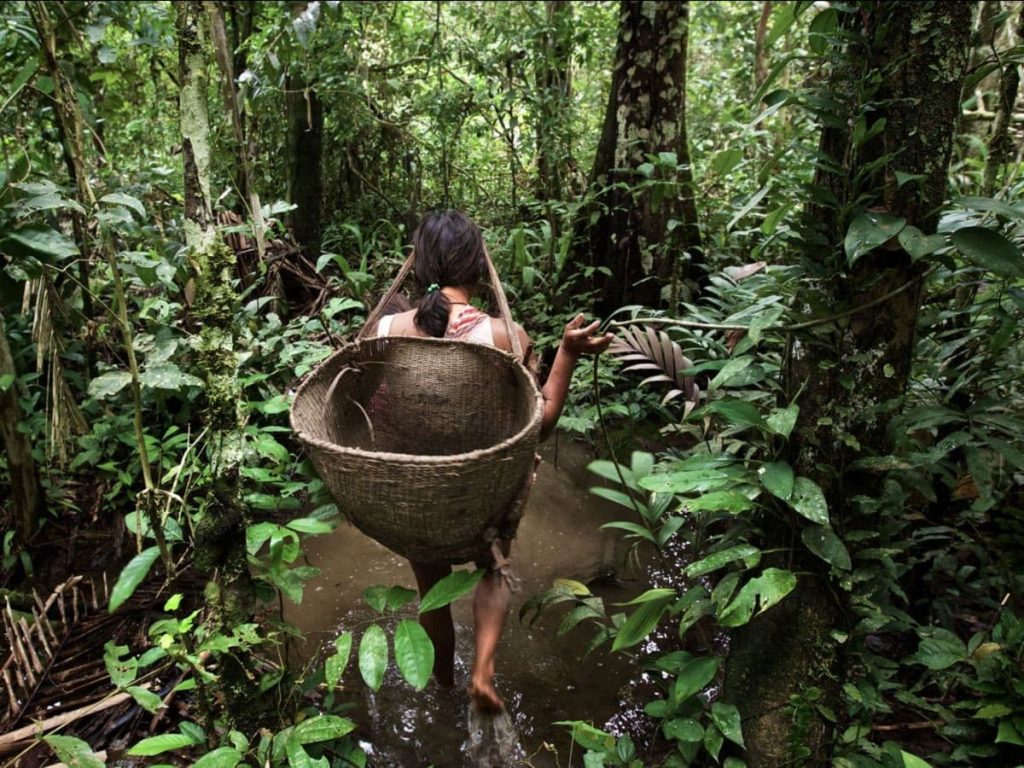
Combining cacao and forests should serve a clear purpose beyond carbon storage.
For example, if your cacao thrives in healthy soils but the surrounding forest is degraded, assigning a purpose to your tree -such as enhancing biodiversity, can connect forest areas and create corridors. This fosters habitat expansion, enabling wildlife and flora to flourish.
In cases where the soil is depleted and the goal is to cultivate healthy cacao forests while restoring the soil, opting for biodiverse cacao agroforestry is recommended. Ensuring these areas are as extensive as possible adds value at a landscape level. Of course, this approach must align with the interests of the farmers involved.
INTEGRATING ‘VALUE FOR NATURE’ IN YOUR PURCHASING DECISIONS
Understanding the ‘contribution of your cacao to nature’ may seem abstract, but here are some practical takeaways:
- Ask questions: Engage with your cacao sourcer to truly understand how your cacao is cultivated and grown. Recognise that there’s no one-size-fits-all model; instead, seek to comprehend the field reality, choices made, and opportunities for improvement.
- Consider the following factors:
- Understand the farmers’ reality and the history of the area.
- Learn about the type of cacao-forest system being used.
- Assess forest cover and diversity within the production system.
- Take note of the proximity to natural reserves.
- Consider the use of agrochemicals
Look at the bigger picture: Understand that it’s not just about the trees above the cacao; take into account the broader ecosystem. Sometimes you can find cacao plots with less shade, where the focus is on more intensive production. Adjacent to these, you might see plots with greater shade, aimed at forest conservation and providing significant biodiversity value.
Finca Betulia, for example, is home to a 30 ha indigenous forest reserve with a great biodiversity of native plants and trees.
Finca Ana Maria features 13 ha of preserved forest, while Finca Paso Cocodrilo includes 10,80 ha of forest and 22,5 ha of agroforestry. Finca Paso Cocodrilo serves as a corridor connecting to National Parque Lachau, creating a vital pathway for the thriving of fauna and flora.

- Recognise varying cultivation methods: Some cacaos are grown in harmony with nature under native forest cover. For example, in Brazil, cacao thrives under the multi-layered Mata Atlantica Forest, practiced by farms like Fazenda Camboa and Fazenda Leolinda. Similarly, in Venezuela, farms like Hacienda Sabaneta and Chuao in Choroni region, and Hacienda Cayetano in Canoabo, embrace this approach.
- Consider field reality: For smallholder farmers, the field reality is unique. They must navigate a small plot of land, balancing cacao cultivation, shade-tree management, and securing enough income. Despite these challenges, agroforestry is often practiced, sometimes out of tradition. This is evident with our partner cooperatives in Uganda, Nicaragua, Congo DRC, Tanzania Kokoa Kamili, Madagascar, Sao Tomé etc.
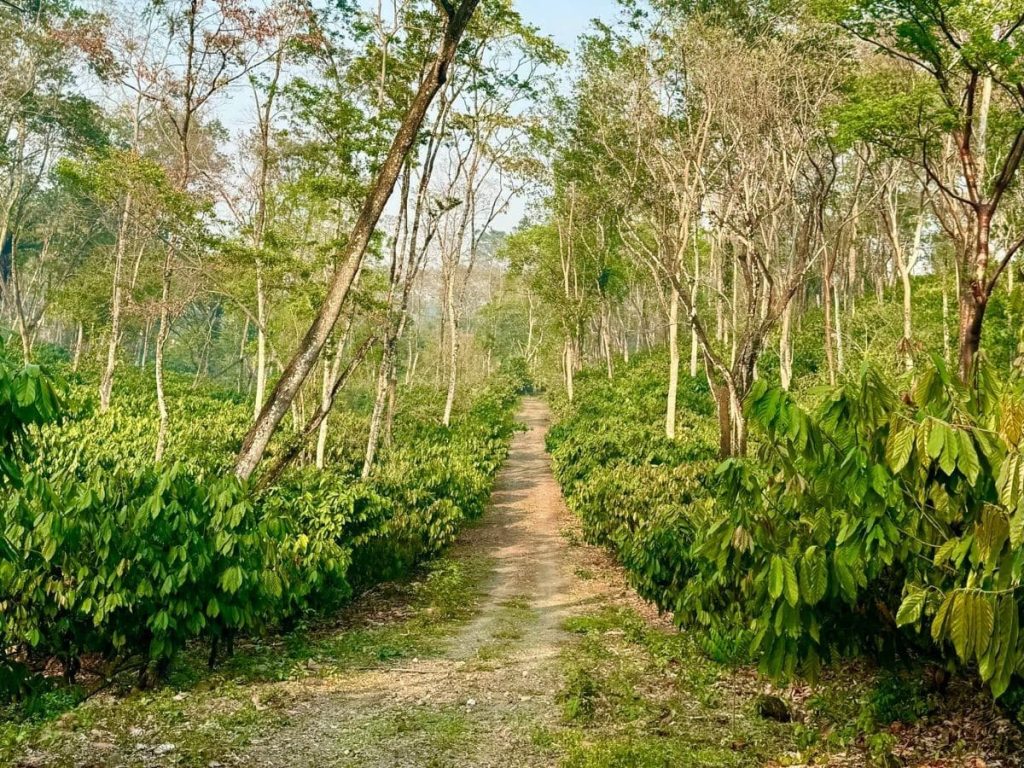
CAN YOU STILL SEE THE FOREST FOR THE TREES
In the meantime, if you’ve lost sight of the bigger picture and want to branch out into the unique agroforestry aspects of specific cacaos, don’t hesitate to get in touch with the Silva team. They’ll help you see the forest and the trees!
Katrien, Jan, Coralie, and Ricardo are here to share their expertise and help you discover the perfect cacao amidst the forest.
COCOA LINE UP
This list is not exhaustive, but gives a good overview.
SILVA CACAO I Guatemala Lachua – Finca Paso Cocodrilo
SILVA CACAO I Guatemala Lachua – Finca Ana Maria
SILVA CACAO I Venezuela – Carabobo Canoabo
SILVA CACAO I Colombia – Betulia B6
SILVA CACAO I Brazil – Fazenda Camboa
SILVA CACAO I Brazil – Fazenda Leolinda
SILVA CACAO I Venezuela – Hacienda la Sabaneta
SILVA CACAO I Venezuela – Chuao
SILVA CACAO I Nicaragua – V’vaya Organic
SILVA CACAO I Tanzania – Kokoa Kamili Organic
SILVA CACAO I Congo – Mayuano Organic
SILVA CACAO I Madagascar – Sambirano – Ambohimena Organic
SILVA CACAO I Sao Tomé – Cantagalo Organic
KUDO’S, CREDITS & INSPIRATION
CUPRIMA I From Canopy to Cup. Exploring Agroforestry in Coffee
SILVA CACAO I Raising the bar with single variety chocolate
SILVA CACAO I The name of fame of Chuao
SILVA CACAO I Nature & Cacao Revival in Uganda
SILVA CACAO I Planting trees as part of the restoration of an ecological corridor in the Northern Mountain Range of the Dominican Republic.
SILVA CACAO I Uganda: Launching a Brand New Cacao Origin
SILVA CACAO I Congo Ituri – Specialty Cacao as a Catalyst for Change
